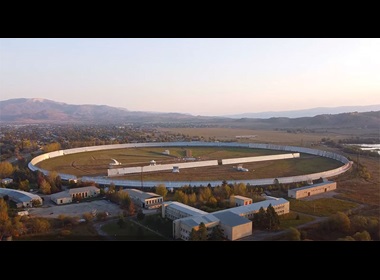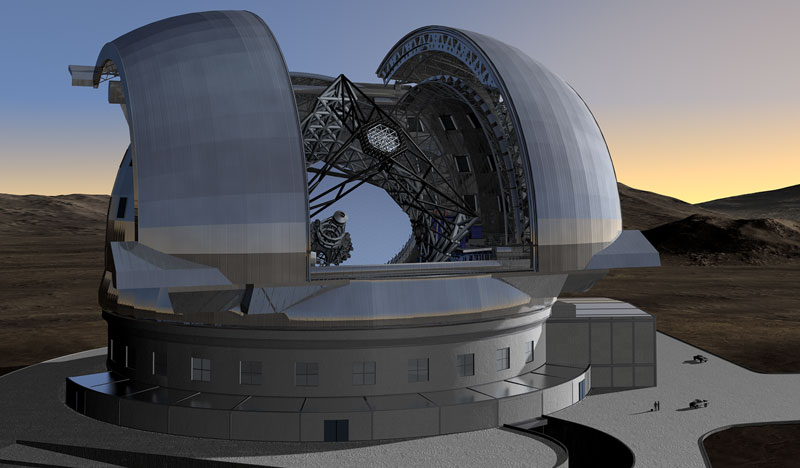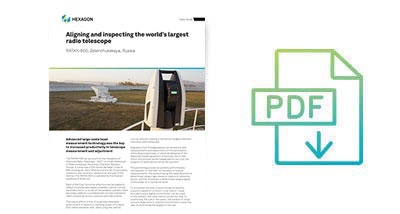Aligning and inspecting the world's largest radio telescope
Advanced large-scale laser measurement technology was the key to increased productivity in telescope measurement and adjustment
Contact us
Large-scale laser measurement: Aligning the world’s largest radio telescope
The RATAN-600 (an acronym for the “Academy of Sciences Radio Telescope – 600”) is a radio telescope in Zelenchukskaya, Karachay–Cherkess Republic, Russia. It comprises a 576-metre diameter circle of 895 rectangular radio reflectors and a set of secondary reflectors and receivers, based at an altitude of 970 metres. The RATAN-600 is operated by the Russian Academy of Sciences.
Each of the 2-by-7.4-metre reflectors can be angled to reflect incoming radio waves towards a central conical secondary mirror, or to one of five parabolic cylinders. Each secondary reflector is combined with an instrumentation cabin containing various receivers and instruments.
The overall effect is that of a partially steerable antenna with a maximum resolving power of a nearly 600-metre-diameter dish, when using the central conical receiver, making it the world‘s largest-diameter individual radio telescope.
Engineers from Promgeodesiya Ltd carried out test measurements and experiments on the automation of the observing modes, in which all elements of the telescope (meaning sectors of the main mirror, flat mirror and booths) would independently carry out the program of observations set by the operator.
 The positioning process is currently performed by the operator “in the field” on the basis of manual measurements. The position along the radial direction is determined using a tape measure relative to reference points, and the inclination is determined using a digital inclinometer (or a cylindrical level).
The positioning process is currently performed by the operator “in the field” on the basis of manual measurements. The position along the radial direction is determined using a tape measure relative to reference points, and the inclination is determined using a digital inclinometer (or a cylindrical level).
To automate the task of positioning the booths, a system based on a robotic total station, linear encoders and a digital inclinometer can be used. In this system, the total station solves the task of positioning the cab in the plane, the system of linear sensors duplicates it, and the inclinometers solve the task of controlling the angles of the cab.
The measurements were taken with a Leica TDRA6000 laser total station, which was positioned on the cab itself and on a stable base near the cab. The total station was positioned from the cab using deflectors on a rail track, or in a second option, mounted on both the rail and the cab.
The cab positioning was also tested using a digital camera-based machine vision system with coded marks. The machine vision camera is attached to the underside of the cab, to view the marks attached at a certain pitch to the rail track.
 A separate task was to determine the shape of the surface of the RATAN-600 main mirror. For accurate and reliable astronomical observations, it is necessary to carry out shape control with an error not exceeding 0.3 millimetres. In order to achieve this accuracy given the size of the main mirror, it was proposed to use a measurement technology based on a combination of two instruments – a Leica Absolute Tracker AT403 ultra-large-volume laser tracker was used to establish a reference network and a Leica Absolute Tracker ATS600 direct scanning laser tracker to scan the surface of the main mirror. The direct scanning functionality of the ATS600 allowed this task to be completed in minimal time, with the tracker positioned centrally and able to take direct measurements from the distant mirror.
A separate task was to determine the shape of the surface of the RATAN-600 main mirror. For accurate and reliable astronomical observations, it is necessary to carry out shape control with an error not exceeding 0.3 millimetres. In order to achieve this accuracy given the size of the main mirror, it was proposed to use a measurement technology based on a combination of two instruments – a Leica Absolute Tracker AT403 ultra-large-volume laser tracker was used to establish a reference network and a Leica Absolute Tracker ATS600 direct scanning laser tracker to scan the surface of the main mirror. The direct scanning functionality of the ATS600 allowed this task to be completed in minimal time, with the tracker positioned centrally and able to take direct measurements from the distant mirror.
Even given measurement to a notoriously challenging mirrored surface, the ATS600 had no trouble in quickly scanning the main mirror to within the required accuracy tolerance.

